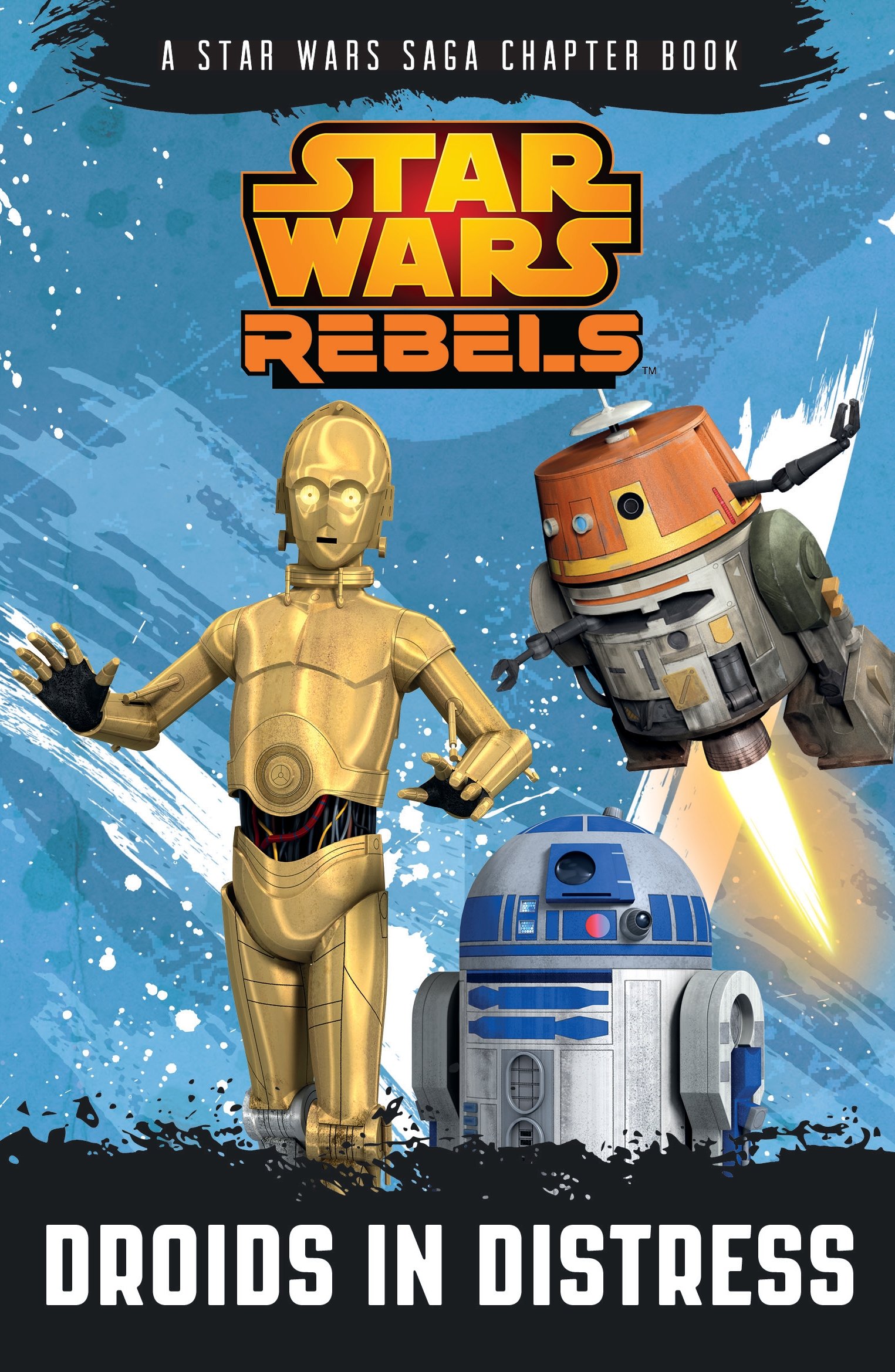Review: Droids In Distress by Michael Kogge (or, Something Meta This Way Comes)
Droids In Distress, by Michael Kogge, is an odd one. For me, that is, as a reviewer. The book itself is good, don’t worry about it. Droids In Distress is a direct translation – from the perspective of Ezra – of the TV series Star Wars: Rebels. Which puts me in a rather odd position. Should I review the story of the episodes? Should I review how the book conveys the story of the episodes? Should I review just the book as its own entity? And there’s the meta aspect of it all: since the book is an adaptation of a TV show, I’m essentially reviewing a synopsis in a book of a TV episode that’s on TV. Okay, I’m slightly confused now. Is this what it’s like to be in the Matrix?

Naturally, if you haven’t seen the TV series, minor spoilers follow.

The Empire is evil! I know, right? I never saw it coming.
Anyhoo. On to the book.
The book conveys the stories told in the TV movie, Spark of Rebellion written by Simon Kinberg, Droids in Distress by Greg Weisman, and Rise of the Old Masters by Henry Gilroy (those links are to our reviews on those episodes, if you want further thoughts on each), and the book itself is written by Michael Kogge. Looking at that list, you may notice something odd. One episode, Fighter Flight, is missing entirely. Which, given that this book is told from Ezra’s perspective, is rather odd. But it doesn’t really impact the book, so I’ll not dwell on it.
Actually, if I could just briefly dwell on it? Fighter Flight is a fairly Ezra-centric episode, more so than Droids in Distress. I was surprised at its exclusion, but if it was a case of choosing between Droids in Distress and Fighter Flight (not sure why that would be the case, but hey ho), then I can understand it, because the former includes a few short scenes which, I think, are necessary to advance Ezra’s story and character. Another reason that I don’t mind its exclusion is that Kogge does a very good job, in terms of writing and overarching theme, of seamlessly continuing the story from Droids in Distress to Rise of the Old Masters.
Back to the synopsis: The book follows Ezra Bridger – a fact that I shall return to periodically; I do apologize for further tautologies. It starts with Ezra in his tower crib, and then a quick cut to Capital City in Lothal, where he happens to spot several ne’er-do-wells (okay, they occasionally do well) trying to steal supplies from the Empire. Spotting a chance to make a lot of money for very little effort (good luck with that, Ezra) he proceeds to rob the thieves. The thieves – Kanan, Sabine and Zeb: three-fourths of the crew of the Ghost, and who will later become Ezra’s companions and friends – take umbrage at this and chase the blue-haired rapscallion down, themselves being chased by the Empire. Boy, thieves just can’t catch a break, can they?

After a short chase, Ezra finds himself trapped. His only option: join the crew of the Ghost; which, to the surprise of no one, he does so. What follows is that Ezra discovers he has a gift: he can touch the Force. What’s more, he finds a teacher in the form of Kanan Jarrus. From then on we follow the teenager through various exploits, as he tries to deepen his understanding of, and connection to, the Force. Also he gets to play with lightsabers. Lucky git.

Now let’s talk about Kogge’s interpretation of the series.
It reads very much like a minute-by-minute synopsis of Spark of Rebellion rather than a novel. It is very basic and has little fleshing out that readers – I’m presuming – would want from a novelization. I think I understand why: the book is split into three segments; each segment being roughly forty pages long. Each segment deals specifically with one episode. However, Spark of Rebellion was a two-part episode. In the book, double the content was placed into a space that worked best for only half that. I don’t know why it is this way, I only say it’s a possible explanation.
Once we finish the first part of the book, the pacing issues disappear almost instantaneously. The writing dramatically improves in quality. It flows more freely and Kogge is able to provide more detail into the thought processes of the characters, provides greater background and world-building detail that expands the universe – not much, admittedly, but enough to satisfy the detail oriented (you know who you are). For example, I had no idea Commandant Aresko and Taskmaster Grint were present from the very first episode. I had previously believed that they were one-and-done characters in the episode Breaking Ranks. But this leads me to believe (and confirmed in the latest episode Empire Day) that they’ll be recurring visitors to the show. Little factoids like this are something I desire from the tie in books. Furthermore, Kogge does convey the events and actions of the story pretty well, so overall I’d count that as a success.
In another book that I reviewed recently, I lamented that the story focused solely on one character – to the detriment of not just the other characters, but the main one as well. This book has a similar set up: it is an adaptation of a TV show, which features several characters, but the book focuses on just one. All the complaints I raise in the other book are rather solidly answered and placed to rest in this one. As I’ve said, the book focuses on Ezra, but other characters, primarily Kanan and Zeb (not so much Hera and Sabine, though I can hardly fault Kogge for this) get a decent amount of page time and fleshing out, which ultimately enhances Ezra’s story, and theirs.
One last thing, and it very much isn’t least – for it’s a charming touch that I adore. Scattered throughout the book are some good quality drawings of the characters: the crew of the Ghost, the Ghost itself, Artoo and Threepio, and even the Inquisitor gets a look in. They’re drawn in a style that’s a cross between the promotional propaganda art and graffiti. As far as I can tell, they’re previously unreleased pieces of art, and I just love them. Embolden and underline that, for it can’t be stressed enough. It almost felt as if Sabine had doodled my copy.

As I flicked through my copy just now, I couldn’t help but feel that this is something ‘adult’ books should pick up again. In infancy, we get books that are basically just pictures, with a few words thrown in. As we grow older, the balance, much like the Force over the course in the films, shifts so that there are more words than pictures. Then, as we grow older still, pictures are eliminated completely. Looking through this book, I can’t help but wonder if this is a misstep. Oh, don’t get much wrong, I love the whole writing thing that we’ve currently got. But, maybe we can have a few pictures, too?
In conclusion: A fairly decent adaptation of the Rebels TV series. And one that is, ultimately, enjoyable. If you’re interested in a novelization of the show, I think you may find this to your liking. Recommended for light bedtime reading for those aged 6 and up.
Star Wars: Droids In Distress by Michael Kogge, published by Egmont, is available now in UK bookstores. Thank you to Egmont Publishing for providing a copy for review purposes.
Author: Michael Dare
Michael Dare is a writer, lives in the UK, and has been slowly coming to terms with the realization that he is not Sherlock, but Watson. He loves Star Wars, dislikes blue milk. Enjoys jumping sharks. Survives on the tears of sexist men, and cheeseburgers.
